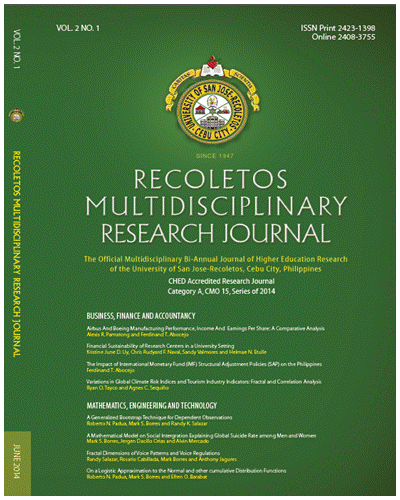Validation of Lepidopteran Classification by Morphological Fractal Dimension Analysis
DOI:
https://doi.org/10.32871/rmrj1402.01.19Keywords:
lepidoptera species, fractal geometry, fractal dimension, morphological dimensions and tresholding effectAbstract
The paper uses fractal geometry through the fractal dimension of photos of the
Lepidopteran species, the commonly named butterflies, collected from the regions of Central Visayas, Philippines to determine if the morphological dimensions can discriminate one species over the other for classification purposes. The images of species were converted into a binary image using the simplest form of image processing known as thresholding effect. The binary images provide a simple view and ease for computing its fractal dimension. The fractal dimension explains the space – filling property of the image. The species available for use were the Cethosia, Idea, Pachliopta, Catopsilia, Troides where 10 subspecies of each were chosen. Also, the male species were isolated and tallied separately from the females. Empirical results revealed that the fractal dimensions can differentiate the species from one another with a general p – value of 0.000 and F – value of 6.483. All sample pairwise comparisons were tested for the significant differences and still differentiates one over the other as evidenced by the corresponding p - values of all equal to 0.000, respectively. Moreover, the fractal dimensions, in relation to the species gender, were tested for possible significant differences, and findings showed that it could differentiate across butterfly’s gender with a p – value of 0.000 and F- value of 8.037. The empirical probability of wrong classification using the fractal dimension is less than 1%.
References
Baltazar, C. R. (1991). An inventory of Philippine Insects II. Order Lepidoptera (Rhopalocera). -399 pp., Los Banos, Philippines (College of Agriculture, University of the Philippines.)
Briggs, J. & Peat, D. F. (1989). Turbulent Mirror. New York: Harper & Row, Publishers, Inc.
Corbet, A. S. & Pendlebury, H.M. (1992). The Butterflies of the Malay Peninsula. Kuala Lumpur. United Selangor Press Sdn. Bhd.
Smart, P. (1976). Encyclopedia of the Butterfly World. Hamlyn Publishing Group Ltd.
Tsukada, E., (1980). Butterflies of the South East Asian Islands, I, Papilionidae.-51, 91, 230-231 pp., 277 incl. 27, 63 pls., Plapac, Japan.
Tsukada, E., (1981). Butterflies of the South East Asian Islands, II, Pieridae. Danaidae.-47-49, 153-157, 262-264, 518-520 pp., incl. 15-17, 113-117 pls., Plapac, Japan.
Tsukada, E., (1985). Butterflies of the South East Asian Islands, IV. Nymphalidae (I).-75, 292 pp., incl. 43 pls., Plapac, Japan.
Journal
Borres, M. (2013). From Fractal Geometry to Statistical Fractal.
Lapinig, V. T., Almirol, C. C., Sabandal, M. O., Gov. Alfonso D. Tan College, Mindanao University of Science and Technology, Northwestern Mindanao State College, Tangub City (2013), Classification of Mangrove
Species Based on Leaf Fractal Dimensions.
Padua, R.; Palompon, D.; Onton, D. (2012). Data Roughness and Fractal Statistics (CNU Journal of Higher Education Research, CHED-JAS Category A, Vol. 7, no. 2.
Literature Cited
Benson, T. (2013, November). Digital Trends: What is DSLR? It’s the camera that raises you from amateur to advanced hobbyist. Retrieved from http://www.digitaltrends.com/photography/what-is-a-dslr/
Cain, A.J. (2014). A classification of living organisms. Encyclopedia Britannica. Retrieved from http://www.britannica.com/EBchecked/topic/584695/taxonomy/48704/A-classification-of-livingorganisms
Chang, A. (1993, February). Fractals in Biological Systems. Retrieved from http://poignance.coiraweb.com/math/Fractals/FractBio/FractBio.html
Dean, C. R., et al. (2013, May). Hofstadter’s butterfly and the fractal quantum Hall effect in moiré superlattices. Nature International weekly journal of Science. Retrieved from http://www.eurekalert.org/pub_releases/2013-05/cu-fdp051313.php
Jeanson, N. T. (2010). New Frontiers in Animal Classification. Retrieved from http://www.icr.org/article/new-frontiers-animal-classification/
Knowlton, N., and J. B. C. Jackson. (1994). New taxonomy and niche partitioning on coral reeds – jack of all trades or master of some. (Trends Ecol. Evol. 9: 7-9)
Kumar, S. (February 2013). Role of Butterflies in the Ecosystem. Retrieved from http://justbefirsttoknow.blogspot.com/2013/02/role-ofbutterflies-in-ecosystem.html
Okubo, P. (2012). Fractal Geometry in the San Andres Fault System. Journal of Geophysical Research: Solid Earth. 92, 345-355. DOI: 10.1029/JB092iB01p00345
Peng, F., Yu, X., Xu, G., and Xia, Q. (2005, NOvember). Fuzzy Classification Based on Fractal Features for Undersea Image. International Journal of Information Technology, Vol. 11. Retrieved from
http://citeseerx.ist.psu.edu/viewdoc/download?doi=10.1.1.97.6264&rep=rep1&type=pdf
Perfect, E. & Kay, B. D. (1995, November). Applications of fractals in soil and tillage research: a review. Soil and Tillage Research, 36 (1-2), 1-20. Retrieved from http://www.sciencedirect.com/science/article/pii/0167198796813973#
Shashikumar, L. ( 2013, March). Butterflies reflect health of ecosystem. Retrieved from http://www.deccanherald.com/content/316469/butterfliesreflect-health-ecosystem.html
Spatz, J. (2013, December). The geometry of cancer cells. Max-Planck-Gesellschaft. Retrieved from http://www.mpg.de/7647926/cancer_cell_fractal
Williams, A. (2009). How to tell the gender of the butterfly. Retrieved from http://animals.pawnation.com/tell-gender-butterfly-6608.html
Downloads
Published
How to Cite
Issue
Section
License
Copyright of the Journal belongs to the University of San Jose-Recoletos


